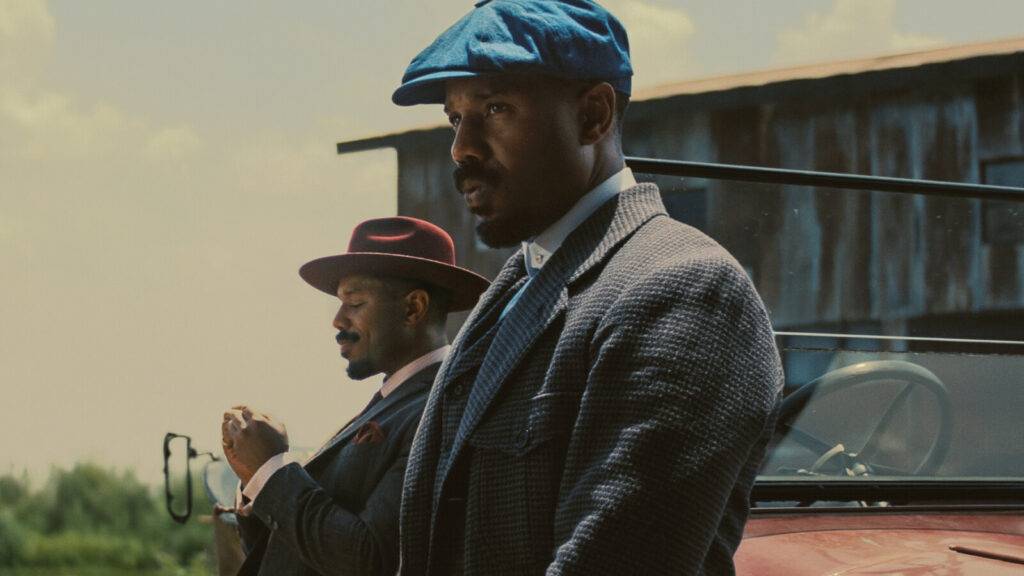Ryan Coogler’s Sinners: Music as Resistance in a Studio Epic
Sinners is the most impressive film of 2025 (so far, at least). Anyone familiar with me and my tastes knows how unlikely it would be for a $90 million Warner Bros. film to be anywhere near my “top of the year” list – we’re one-third of the way through 2025, and Sinners is doing just that. Generally, big-budget movies feel driven by market trends rather than unique artistry – but Sinners is a rare exception. It manages to appeal to diverse groups – it’s layered enough for us “pretentious” film folk, genre-rich enough for fans of horror and vampire flicks, and delivers the action sequences that so many others desire. As a result, Ryan Coogler achieves something genuinely extraordinary here.
What is Sinners About?

Sinners follows twin brothers, both portrayed by Michael B. Jordan, as they return to their hometown of Clarksdale, Mississippi, after years spent in Chicago. They’re carrying a substantial sum of cash and ambitions to open a juke joint – but they aren’t able to execute their plans without hurdles in the way – old lovers, racist landowners, and, of course, vampires.
Defining Sinners isn’t straightforward: it’s part vampire tale, part historical drama, part gangster thriller, and part musical. It’s an ambitious blend, and most directors would stumble trying to manage so many moving pieces – yet Coogler’s inescapable confidence ensures each element not only makes sense but also secures the audience’s trust. The film holds your attention from its first cutaway and maintains that grip throughout peaks of tension and valleys of interpersonal connection.
The film isn’t just resonating with me – it’s taken hold of audiences across the continent, opening bigger than any original film since Jordan Peele’s Us in 2019. In today’s franchise-heavy market, that’s no small feat. But the story behind Sinners isn’t limited to box-office success. Coogler fought hard for creative control – securing final-cut rights, first-dollar gross, and – remarkably for a studio film – full ownership after 25 years. This represents more than just a win for Coogler; it signifies a rare instance of a major studio genuinely empowering a Black filmmaker to tell a profoundly Black story about ownership, culture, and history.
Historical Context, Production Design, and Music
Set during the Jim Crow era in Mississippi, the film meticulously incorporates historical realities like sharecropping and the oppressive crop-lien system, which trapped Black farmers in perpetual debt. Within this context, the juke joint isn’t simply a business but an act of resistance – a communal space reclaiming joy amidst oppression. Hannah Beachler, the production designer, cleverly emphasizes segregation’s impact through detailed set designs that include separate “upstairs” and “back room” areas.
Within this broader historical context, the music of the time forms the emotional heart of Sinners, shaping both its narrative structure and thematic resonance. Ludwig Göransson, the composer, grounds his score with a vintage 1932 Dobro resonator guitar, evoking archival Delta blues recordings. Structurally, the film mirrors its musical composition, with Coogler writing Sinners as if it were a song, layering verses until we reach the thundering “chorus” at the midpoint. Beyond the blues, Coogler also integrates Irish folk traditions, most notably through a beautifully choreographed step-dance sequence – drawing parallels between Irish and Black musical expressions of resilience, both born from trauma yet transformed into powerful communal experiences.
The Juke Joint Scene

The clearest illustration of the music’s emotional power is the four-minute central sequence – the chorus inside the juke joint. Miles Caton, delivering his acting debut after years as a child musician, commands attention the instant he begins singing. His blues performance evolves from grounded realism into something surreal and otherworldly. As Caton’s voice fills the room, the camera glides through the roof of the juke joint and back down through the building, now engulfed in flames. We move through the entirety of the space – witnessing the transcendental nature of music firsthand. We see ancestors. We see people yet to come. We see the art, culture, and community that have often been pushed into basements and back rooms.
That scene is the most powerful of the year, and it exemplifies many acts of brilliance from the director of photography, Autumn Durald Arkapaw. Captured on large-format IMAX 70 mm film, her cinematography skillfully complements Coogler’s vision. Arkapaw frequently employs shallow depth of field to maintain intimate character focus and strategically shifts to anamorphic lenses when scenes veer into more “mystical” territory. Notably, Arkapaw is the first woman cinematographer to shoot a major studio film on IMAX 70 mm – a significant industry milestone.
Michael B. Jordan in Sinners
Michael B. Jordan delivers one of his most demanding performances to date, portraying twins Elijah and Elias. He distinguishes each character through nuanced posture, vocal cadence, and subtle emotional shifts, and Coogler even brought a pair of real-life twins on set for Jordan to learn from. Remarkably, many of the dual-character scenes were captured in camera – Jordan would perform one role on one side of a locked-off shot, then switch sides for the other twin, with the film physically spliced together. For more complex moments, the team used a “halo rig” to superimpose Jordan’s face onto a body double – a monumental ask of the actor.
Should You Watch Sinners?

Sinners is for everyone, but Coogler doesn’t shy away from addressing cultural appropriation and erasure. This is most clearly voiced through Delta Slim (portrayed by Delroy Lindo), who doesn’t pull any punches – “White folks, they like the blues just fine. They just don’t like the people who make it.” The film articulates a painful historical reality – how Black cultural contributions are frequently embraced yet stripped of their context and creators – and Sinners engages deeply with this contradiction, confronting it head-on.
At its core, Sinners exemplifies music’s transcendent power – its unique ability to transport audiences emotionally and culturally. Beyond vampires, beyond music, beyond resistance, this film profoundly captures the importance of those who carry these legacies forward. Oh, and don’t be that person who leaves the theatre the second the credits start rolling – you won’t want to miss the post-credits sequence.
Read More:



